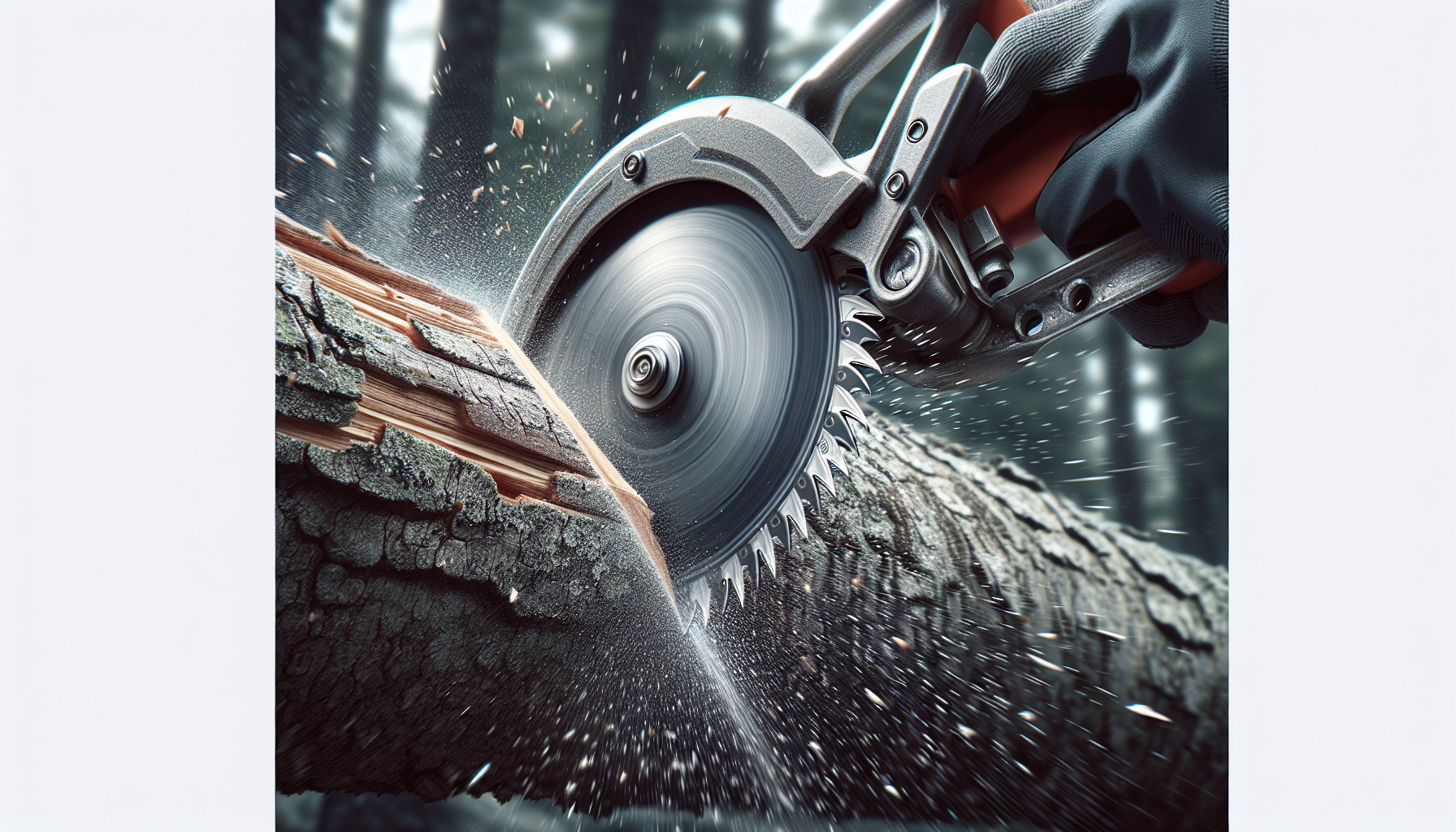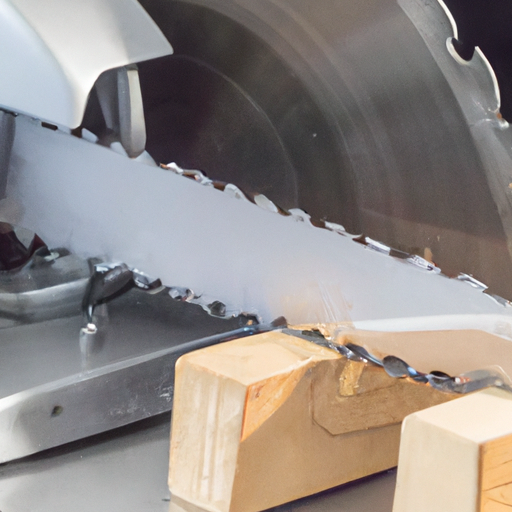Imagine being able to trim trees and branches effortlessly with a tool that can cut through even the thickest of limbs. That’s exactly what a pole saw offers – the ability to reach and shape trees from a safe distance. But have you ever wondered just how thick these ingenious tools can actually cut? From tackling smaller branches to confidently taking on larger ones, pole saws have the power to transform your tree trimming experience. In this article, we’ll explore the impressive capabilities of pole saws and provide you with a deeper understanding of how thick they can truly cut. Get ready to elevate your tree maintenance game to new heights!
Understanding Pole Saws
Definition of a Pole Saw
A pole saw is a specialized tool used for cutting and trimming branches and limbs from trees. It consists of a long, extendable pole with a cutting head attached at one end. The cutting head typically includes a chainsaw bar and chain, powered either by a gasoline engine or an electric motor. Pole saws are designed to allow tree maintenance and pruning even in hard-to-reach areas, making them an essential tool for arborists, gardeners, and homeowners.
Types of Pole Saws
There are two main types of pole saws: gas-powered and electric. Gas-powered pole saws are generally more powerful and suitable for heavy-duty cutting tasks. They provide the freedom to move around without being limited by a power cord, making them ideal for larger properties or remote areas where access to electricity may not be available. On the other hand, electric pole saws are more lightweight, quieter, and easier to maintain. They are favored by homeowners and those with smaller trees to trim. Electric pole saws can be further divided into corded and cordless models, providing flexibility in terms of mobility and power source.
Factors Affecting Pole Saw Cutting Depth
Bar Length
The bar length of a pole saw refers to the length of the cutting blade or guide bar. It plays a crucial role in determining the cutting depth that the pole saw can achieve. Generally, the longer the bar length, the deeper the saw can cut. Longer bars allow for more extensive reach and can tackle thicker branches. However, it is important to note that using an excessively long bar on a pole saw can affect its maneuverability and balance, making it more challenging to control.
Chain Gauge
Chain gauge refers to the thickness of the drive links on the chainsaw chain. It directly affects the cutting capacity of a pole saw. Chains with larger chain gauges are more robust and can cut through thicker branches. However, it is crucial to ensure that the chain gauge matches the specifications of the pole saw, as using an incompatible chain gauge can lead to poor cutting performance, increased wear and tear on the chain, and potential safety hazards.
Chain Tension
Proper chain tension is essential for optimal cutting depth. If the chain is too loose, it may not engage properly with the bar, resulting in reduced cutting efficiency. Conversely, an overly tight chain can strain the motor and increase the risk of kickbacks. Regularly checking and adjusting the chain tension is crucial to ensure safe and effective cutting. Following the manufacturer’s guidelines for chain tension is recommended, as different models may have specific requirements.
Motor Power
The motor power of a pole saw determines the strength and cutting capacity of the tool. Gas-powered pole saws typically have higher motor power ratings compared to electric models, providing greater cutting force. Higher motor power allows for smoother and faster cuts through thicker branches. However, it is important to choose a motor power that aligns with your cutting needs. Overpowering a pole saw may result in unnecessary weight and more challenging handling.
Cutting Technique
While the above factors contribute significantly to cutting depth, the cutting technique employed is equally vital. Mastering the right angle and approach to the branch, applying the correct pressure, avoiding pinching, kickbacks, and maintaining a steady motion all play a role in maximizing the cutting depth of a pole saw. Practicing proper cutting techniques not only ensures efficient cutting but also enhances safety during tree maintenance tasks.
Bar Length and Its Impact on Cutting Depth
How Bar Length Affects Cutting Depth
Bar length directly impacts the cutting depth that a pole saw can achieve. A longer bar allows for a larger cutting reach and the ability to tackle thicker branches. For example, a pole saw with a 10-inch bar length is suitable for cutting branches up to 6 inches in diameter, while a 12-inch bar length can handle branches up to 8 inches in diameter. However, it is important to consider the overall weight and balance of the pole saw when selecting a longer bar length, as it can affect maneuverability.
Recommended Bar Lengths for Various Thicknesses
When choosing a pole saw, it is helpful to refer to recommended bar lengths for different thicknesses of branches. For branches up to 4 inches in diameter, a 6-8 inch bar length is typically sufficient. For branches 4 to 6 inches in diameter, a 10-12 inch bar length is recommended. For branches 6 to 8 inches in diameter, a 14-16 inch bar length may be necessary. It is important to note that these are general guidelines, and the performance may vary depending on the specific model and cutting conditions.
Chain Gauge and Its Influence on Cutting Depth
What is Chain Gauge?
Chain gauge refers to the thickness of the drive links on the chainsaw chain. It is an important factor that determines the cutting capacity and overall performance of a pole saw. The most common chain gauges for pole saws are 0.050″, 0.058″, and 0.063″. The larger the chain gauge, the thicker the branches the pole saw can cut through.
Effects of Chain Gauge on Cutting Capacity
Using a chain with a larger gauge allows for more aggressive cutting and the ability to tackle thicker branches. For example, a pole saw with a 0.050″ chain gauge can typically handle branches up to 4 inches in diameter, while a 0.058″ chain gauge can tackle branches up to 6 inches in diameter. It is essential to select a chain gauge that matches the specifications of the pole saw to ensure optimal cutting performance and minimize the risk of damage to the chainsaw chain.
Suitable Chain Gauges for Different Thicknesses
To effectively cut through branches of various thicknesses, it is helpful to choose a suitable chain gauge. For branches up to 4 inches in diameter, a 0.050″ chain gauge is recommended. For branches 4 to 6 inches in diameter, a 0.058″ chain gauge is suitable. For branches 6 to 8 inches in diameter, a 0.063″ chain gauge may be necessary. It is advised to consult the manufacturer’s guidelines and specifications to determine the appropriate chain gauge for your specific pole saw model.
Chain Tension and Its Role in Cutting Depth
Importance of Proper Chain Tension
Proper chain tension is vital for achieving optimal cutting depth and performance. If the chain is too loose, it may not engage properly with the bar, resulting in reduced cutting efficiency and potentially leading to chain derailment. On the other hand, an overly tight chain can strain the motor, increase friction, and pose a safety risk. Maintaining proper chain tension ensures that the saw operates smoothly and allows for accurate and efficient cutting.
How Chain Tension Affects Cutting Depth
Improper chain tension significantly impacts cutting depth. A loose chain may cause the pole saw to “bog down” and struggle to cut through branches, leading to shallower cuts. Conversely, an excessively tight chain can increase the risk of kickbacks and damage to the chain and other components. Regularly checking and adjusting chain tension according to the manufacturer’s guidelines is crucial to maintain optimal cutting depth and ensure safe operation.
Motor Power and Cutting Depth
Understanding Motor Power Rating
The motor power rating of a pole saw determines its cutting capacity and ability to tackle thicker branches. Motor power is measured in amps for electric pole saws and in cubic centimeters (cc) for gas-powered models. Higher motor power generally corresponds to more significant cutting force and deeper cuts. However, it is important to consider your specific cutting needs and the weight and handling of the pole saw, as excessive motor power may not always be necessary.
Impact of Motor Power on Cutting Capacity
Higher motor power enables a pole saw to cut through thicker branches with greater ease. For example, an electric pole saw with 8 amps of motor power can handle branches up to 6 inches in diameter, while a gas-powered model with 45cc of motor power can tackle branches up to 12 inches in diameter. Understanding the cutting capacity of different motor power ratings allows you to select a pole saw that aligns with your specific cutting requirements.
Mastering Cutting Technique for Maximum Depth
Choosing the Right Angle and Approach
To achieve maximum cutting depth, choosing the right angle and approach to the branch is essential. It is generally recommended to approach the branch from above and make a downward cut. This allows gravity to assist in the cutting process, providing better control and maximizing the cutting depth.
Applying the Correct Pressure
Applying the correct pressure while cutting is crucial for achieving optimal cutting depth. Pushing too hard can cause the saw to bind or get stuck, while exerting too little pressure may result in shallower cuts. Finding the right balance and applying consistent pressure throughout the cut ensures efficient cutting and prevents unnecessary strain on the pole saw.
Avoiding Pinching and Kickbacks
Pinching occurs when the branch being cut closes in on the chainsaw, potentially leading to kickbacks or the pole saw getting stuck. To avoid pinching, it is important to maintain awareness of the weight distribution and tension in the branch. Making strategic relief cuts and carefully managing the forces involved can help minimize the risk of pinching and enhance the cutting depth.
Maintaining a Steady Motion
Maintaining a steady motion while cutting with a pole saw is vital for achieving maximum cutting depth. Smooth and controlled movements help maintain the alignment of the blade, allowing for cleaner and deeper cuts. Avoiding sudden jerks or lateral movements helps ensure consistency in the cutting process and prevents potential damage to the pole saw.
Pole Saw Limitations
Other Factors That Can Limit Cutting Depth
While pole saws are designed to handle various cutting tasks, there are limitations to their cutting depth capabilities. Factors such as the overall weight and balance of the pole saw, the hardness and density of the wood being cut, and the condition of the chainsaw chain can all influence the maximum cutting depth achievable. It is important to consider these factors and make appropriate adjustments to optimize cutting performance.
Pole Saw Safety Measures
When using a pole saw, safety should always be a top priority. Wearing appropriate protection, including safety goggles, gloves, and sturdy footwear, is essential. Maintaining a safe distance from power lines and other potential hazards is crucial. Following the manufacturer’s instructions, regular maintenance, and proper handling and storage of the pole saw are also important for ensuring safe operation and maximizing the cutting depth.
Conclusion
The cutting depth of a pole saw is influenced by several factors, including bar length, chain gauge, chain tension, motor power, and cutting technique. Understanding how these factors impact cutting depth allows you to select the right pole saw and employ proper techniques to achieve optimal cutting results. By considering the thickness of the branches you need to cut and matching the specifications of the pole saw accordingly, you can ensure efficient and safe tree maintenance. Keep in mind the limitations of pole saws and always prioritize safety to make the most out of your pole saw and enjoy the benefits of a well-maintained landscape.



